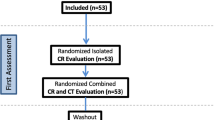Abstract
Summary
We report the bone attenuation of ankle joint measured on computed tomography (CT) and the cause of injury in patients with ankle fractures. The results showed age- and gender-dependent low bone attenuation and low-energy trauma in elderly females, which suggest the osteoporotic features of ankle fractures.
Introduction
This study was performed to investigate the osteoporotic features of ankle fracture in terms of bone attenuation and cause of injury.
Methods
One hundred ninety-four patients (mean age 51.0 years, standard deviation 15.8 years; 98 males and 96 females) with ankle fracture were included. All patients underwent CT examination, and causes of injury (high/low-energy trauma) were recorded. Mean bone attenuations of the talus, medial malleolus, lateral malleolus, and distal tibial metaphysis were measured on CT images. Patients were divided into younger age (<50 years) and older age (≥50 years) groups, and mean bone attenuation and causes of injury were compared between the two groups in each gender.
Results
Proportion of low-energy trauma was higher in the older age group than in the younger age group, but the difference was only significant in female gender (p = 0.011). The older age group showed significantly lower bone attenuation in the talus, medial malleolus, lateral malleolus, and distal tibial metaphysis than the younger age group in both genders. The older age group showed more complex pattern of fractures than the younger age group. With increasing age, bone attenuations tended to decrease and the difference of bone attenuation between the genders tended to increase in the talus, medial malleolus, lateral malleolus, and distal tibial metaphysis.
Conclusions
Ankle fracture had features of osteoporotic fracture that is characterized by age- and gender-dependent low bone attenuation. Ankle fracture should not be excluded from the clinical and research interest as well as from the benefit of osteoporosis management.


Similar content being viewed by others
References
Boonen S, Singer AJ (2008) Osteoporosis management: impact of fracture type on cost and quality of life in patients at risk for fracture I. Curr Med Res Opin 24:1781–1788
Chrischilles EA, Butler CD, Davis CS, Wallace RB (1991) A model of lifetime osteoporosis impact. Arch Intern Med 151:2026–2032
van Staa TP, Dennison EM, Leufkens HG, Cooper C (2001) Epidemiology of fractures in England and Wales. Bone 29:517–522
Caliri A, De Filippis L, Bagnato GL, Bagnato GF (2007) Osteoporotic fractures: mortality and quality of life. Panminerva Med 49:21–27
Lane NE (2006) Epidemiology, etiology, and diagnosis of osteoporosis. Am J Obstet Gynecol 194:S3–S11
Gosch M, Roth T, Kammerlander C, Joosten-Gstrein B, Benvenuti-Falger U, Blauth M, Lechleitner M (2011) Treatment of osteoporosis in postmenopausal hip fracture patients after geriatric rehabilitation: changes over the last decade. Z Gerontol Geriatr 44:381–386
Christenson ES, Jiang X, Kagan R, Schnatz P (2012) Osteoporosis management in post-menopausal women. Minerva Ginecol 64:181–194
Reginster JY (2011) Antifracture efficacy of currently available therapies for postmenopausal osteoporosis. Drugs 71:65–78
Center JR, Bliuc D, Nguyen ND, Nguyen TV, Eisman JA (2011) Osteoporosis medication and reduced mortality risk in elderly women and men. J Clin Endocrinol Metab 96:1006–1014
Beaupre LA, Morrish DW, Hanley DA, Maksymowych WP, Bell NR, Juby AG, Majumdar SR (2011) Oral bisphosphonates are associated with reduced mortality after hip fracture. Osteoporos Int 22:983–991
Hasselman CT, Vogt MT, Stone KL, Cauley JA, Conti SF (2003) Foot and ankle fractures in elderly white women. Incidence and risk factors. J Bone Joint Surg Am 85-A:820–824
Greenfield DM, Eastell R (2001) Risk factors for ankle fracture. Osteoporos Int 12:97–103
Briancon D, de Gaudemar JB, Forestier R (2004) Management of osteoporosis in women with peripheral osteoporotic fractures after 50 years of age: a study of practices. Joint Bone Spine 71:128–130
Kim T, Ayturk UM, Haskell A, Miclau T, Puttlitz CM (2007) Fixation of osteoporotic distal fibula fractures: a biomechanical comparison of locking versus conventional plates. J Foot Ankle Surg 46:2–6
Panchbhavi VK, Vallurupalli S, Morris R, Patterson R (2008) The use of calcium sulfate and calcium phosphate composite graft to augment screw purchase in osteoporotic ankles. Foot Ankle Int 29:593–600
Cole PA, Craft JA (2002) Treatment of osteoporotic ankle fractures in the elderly: surgical strategies. Orthopedics 25:427–430
Pickhardt PJ, Lee LJ, del Rio AM, Lauder T, Bruce RJ, Summers RM, Pooler BD, Binkley N (2011) Simultaneous screening for osteoporosis at CT colonography: bone mineral density assessment using MDCT attenuation techniques compared with the DXA reference standard. J Bone Miner Res 26:2194–2203
Romme EA, Murchison JT, Phang KF, Jansen FH, Rutten EP, Wouters EF, Smeenk FW, Van Beek EJ, Macnee W (2012) Bone attenuation on routine chest CT correlates with bone mineral density on DXA in patients with COPD. J Bone Miner Res 27:2338–2343
Miyabara Y, Holmes D III, Camp J, Miller VM, Kearns AE (2012) Comparison of calibrated and uncalibrated bone mineral density by CT to DEXA in menopausal women. Climacteric 15:374–381
Fleiss JL (1981) Statistical methods for rates and proportions, 2nd edn. Wiley, New York
Thur CK, Edgren G, Jansson KA, Wretenberg P (2012) Epidemiology of adult ankle fractures in Sweden between 1987 and 2004: a population-based study of 91,410 Swedish inpatients. Acta Orthop 83:276–281
Johnell O, Kanis J (2005) Epidemiology of osteoporotic fractures. Osteoporos Int 16(Suppl 2):S3–S7
Adams JE (2009) Quantitative computed tomography. Eur J Radiol 71:415–424
Link TM, Koppers BB, Licht T, Bauer J, Lu Y, Rummeny EJ (2004) In vitro and in vivo spiral CT to determine bone mineral density: initial experience in patients at risk for osteoporosis. Radiology 231:805–811
Acknowledgments
The authors wish to thank Mi Seon Yoo, BS and Hyun Mi Kim, BS for their technical support and heartful advice.
Conflicts of interest
None
Author information
Authors and Affiliations
Corresponding author
Rights and permissions
About this article
Cite this article
Lee, K.M., Chung, C.Y., Kwon, S.S. et al. Ankle fractures have features of an osteoporotic fracture. Osteoporos Int 24, 2819–2825 (2013). https://doi.org/10.1007/s00198-013-2394-6
Received:
Accepted:
Published:
Issue Date:
DOI: https://doi.org/10.1007/s00198-013-2394-6




